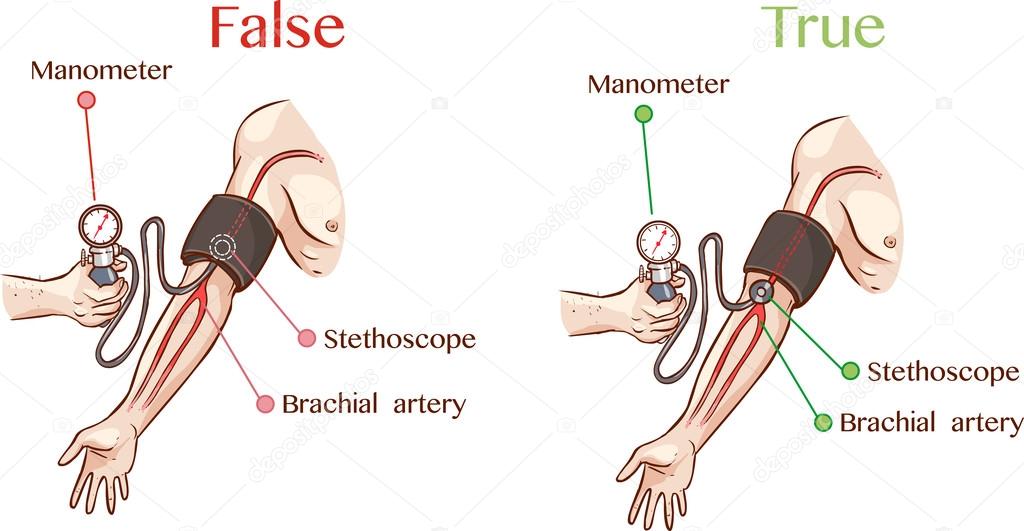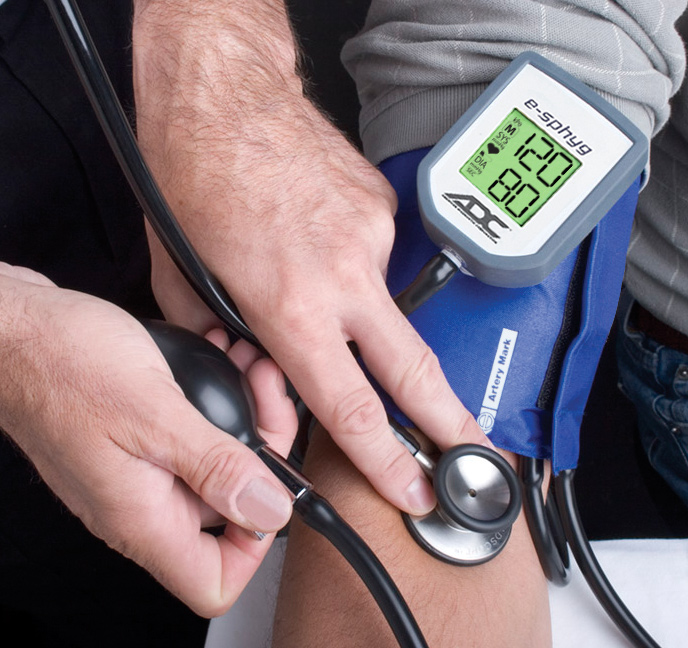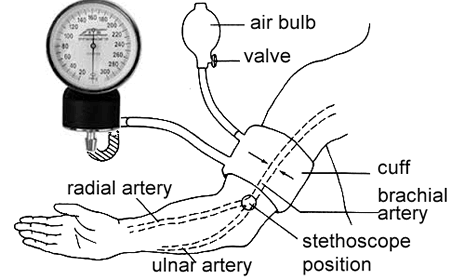Blood Press Monit 1999. Normal sounds of the lungs occur in all parts of the chest area including the rib cages bottom and right above the collarbones.

How To Appropriately Measure Blood Pressure In A Practice Setting Youtube
The arm being used should be relaxed uncovered and supported at the level of the heart.

. If unable to palpate an artery because of a weak pulse use an ultrasonic stethoscope. Using alcohol and wipes clean the earpieces and stethoscope diaphragm and allow to dry. Partially tuck the bell of the stethoscope under the blood pressure.
In general blood pressure should be measured while you are seated comfortably. The diaphragm must be placed flat against the skin on the arm of the patient. Only after the diaphragm is in place should the ear pieces of the stethoscope be placed in the ears to start listening to the blood flow.
Typically readings are taken every 15 to 30 minutes for 24 hours. Lawrence A low index number warns the Mayo Clinic likely indicates arterial narrowing or blockage in the legs. A built-in stethoscope bell be sure to position the cuff so the bell is over the artery.
Once you understand why you need a stethoscope when taking blood pressure it is also essential to be familiar with how it should be placed. Only the part of the arm where the blood pressure cuff is fastened needs to be at heart level not the entire arm. This is known as----- 2.
The diaphragm must be placed flat against the skin on the arm of the patient. Effect of back support and stethoscope head on seated blood pressure determinations. Ambulatory blood pressure monitoring is a noninvasive automated process that records blood pressure over an extended period.
Beyond the ankle another alternative is a calf-based blood pressure reading. The cuff should be placed snugly around the upper arm and the bladder of the cuff should cover at least 80 of the arms circumference. The standard for blood pressure cuff placement is the upper arm using a cuff on bare skin with a stethoscope placed at the elbow fold over the brachial artery.
In clinical practice it is sometimes placed under the cuff but more usually outside the cuff on the antecubital fossa. The effect of crossing legs on blood pressure. The lower end of the blood pressure cuff is placed 2-3 cm above the antecubital fossa which should be at approximately the same vertical height as the heart while allowing room for the stethoscope.
Am J Hypertens 1990. Place the inflatable blood pressure cuff securely on the upper arm. The circumference of the diaphragm must be just underneath the cuff and be positioned over the artery.
The manual auscultatory method is the gold standard for clinical BP measurement and requires a cuff a stethoscope and a cuff pressure display. However there is little scientific evidence to quantify the BP difference between the BP measurements taken with. The correct positioning of the cuff as shown by the Artery Mark and stethoscope for optimal measurement.
Know where the stethoscope is supposed to be placed on your arm. Facing your seated and relaxed partner place the diaphragm of the stethoscope in each of the locations shown in Figure 44. Listen to the blood flow.
Your patient has a blood pressure of 142100. Do not place chestpiece underneath the cuff as this impedes accurate measurement. Lower Extremity - CE ALERT.
Palpate for a radial pulse. I work in pych and have a number of patients that require creativity in getting vital signs this is how I take blood pressure on the forearm with manual equipment Place the BP cuff around the forearm just below the elbow. The lower end of the blood pressure cuff is placed 2-3 cm above the antecubital fossa which should be at approximately the same vertical height as the heart while allowing room for the stethoscope.
During the blood pressure measurement the doctor will place the stethoscope on the brachial artery which is in your arm to listen to your blood flow. Blood Pressure Cuff Placement For the best cuff placement it should be wrapped around the upper arm just above your elbow bend. Sometimes your healthcare provider will take your blood pressure while you are reclined or while you are standing up.
You can compare systolic ankle leg pressure to systolic brachial arm blood pressure and this is termed the ankle-brachial pressure index ABPI says Dr. If your answer is. 2 The appearance and.
It should always be placed directly on the skin to give an accurate reading. 1 If the cuff has no center arrows estimate the center of the bladder and place it. Blood pressure BP measurements with an electronic BP device may be affected by excessive movement such as with seizures tremors or shivering and irregular heart rates.
When measuring blood pressure BP using the auscultation method a stethoscope is commonly used. Placement of the stethoscope on the left facing the patient inter-costal space between rib 2 and 3 will allow for the sound produced by the -----valve to be heard. For the following blanks you must include artery in your answer ie.
Then place your stethoscope and take the blood pressure how you normally would. Rotate the stethoscope earpieces so they will face slightly anterior before placing in your ears. The OhioAFP in partnership with the Ohio Department of Health Dr.
A randomized single-blind cross-over study. A blood pressure cuff should never be placed over clothing. Position the chestpiece in the antecubital space below the cuff distal to the brachium.
This only applies if your pressure is taken the old-fashioned waywith a sphygmomanometer. Place your stethoscope over the flat part of the inner wrist closest to the radial artery side. Position the bell of the stethoscope over where you felt the pulsation of your brachial artery.
1 A trained clinician or nurse uses the stethoscope to listen for the Korotkoff sounds associated with blood flowing through the brachial arm artery as a BP cuff encircling the upper arm is deflated. Google Scholar Peters GL Binder SK Campbell NR. I actually had to do this when I went through my home health rotation a lot dt IVsPICC lines that pts would have.
Find the radial pulse and the place the artery arrow on the cuff over the radial artery. Apply the cuff by centering the arrows marked on the cuff over the popliteal artery so that the lower edge of the cuff is 2 to 3 cm about 1 inch above the popliteal fossa.

Ppt This Demonstrates The Location Of The Cuff And Placement Of The Stethoscope For Taking Blood Pressure Powerpoint Presentation Id 632605
Stethoscope Bell And Sphygmomanometer Cuff Placement

Blood Pressure 2 Procedures For Measuring Blood Pressure Nursing Times

How To Take Blood Pressure American Diagnostic Corporation
Vital Signs Client Care Nursing Part 5

Blood Pressure Symbol Vector Illustration True False Stock Vector Image By C Corbacserdar Gmail Com 109512494


0 comments
Post a Comment